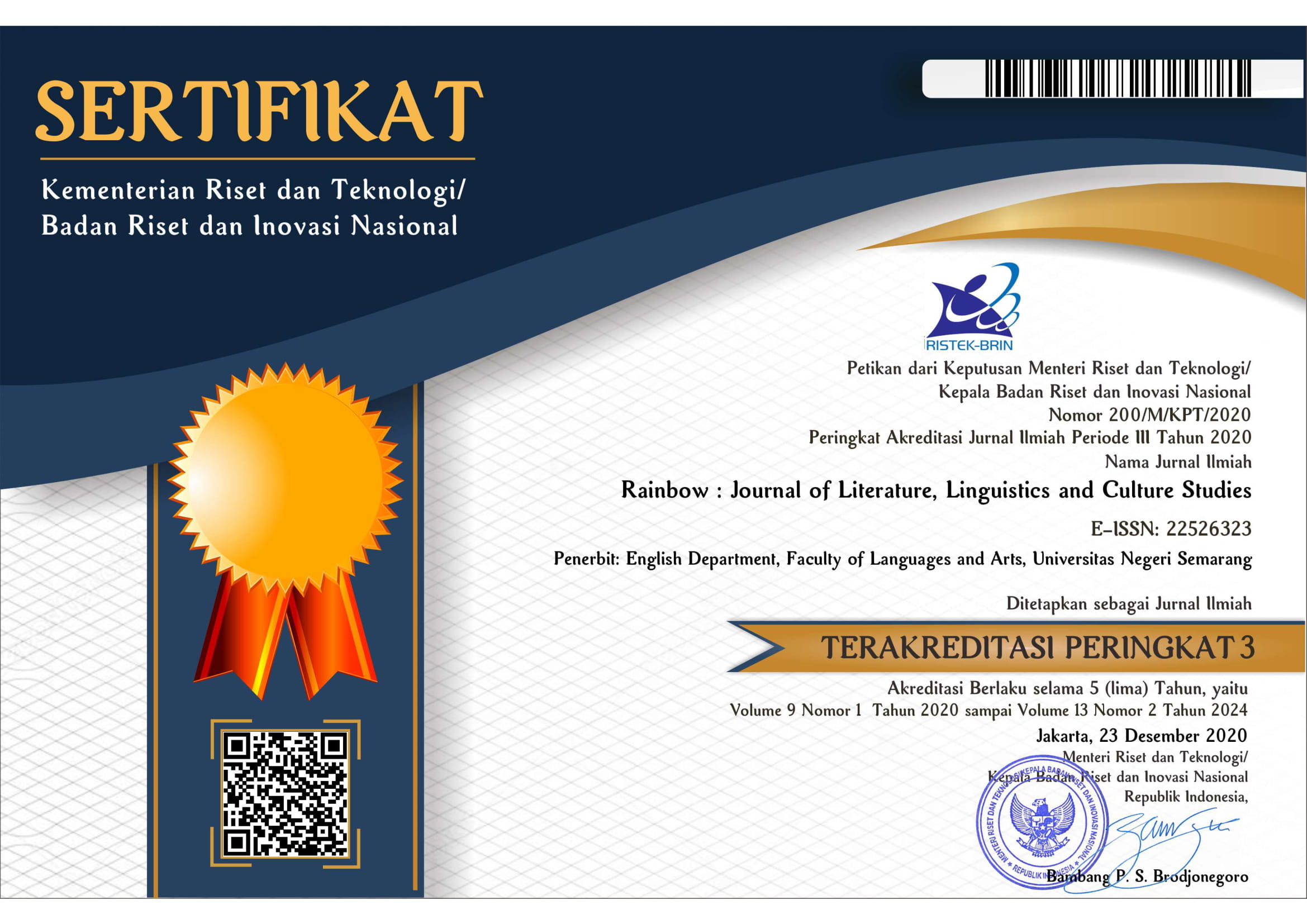Sugiharti Halim (2008): A Cinematic Portrayal of Chinese Indonesian's Ambiguous Identity
Abstract
Sugiharti Halim (2008) provides a cinematic insight into the lives of Chinese Indonesians whose identities are perpetually labeled as liyan (other) in the eyes of the inlanders (pribumi). It narrates the story of Sugiharti Halim, a Chinese Indonesian girl, who struggles with her Indonesian sounding name which, instead of successfully assimilating her Chinese identity, makes her even more Chinese than before. This study aims to investigate the cinematic portrayal of Chinese Indonesian’s ambiguous identity as experienced by the female protagonist. The writer employs close textual analysis of the indie film and approaches the issue by the reading of cinematic codes (mise en scene) and the theoretical perspective of name giving developed by Watzlawik in 2016. The conflict highlited in this “indie” criticizes the position of Chinese filmmaker for being pigeoholed on the ground of their ethnicity as portrayed in most commercial films which put Chinese more as a marginalized group. Therefore, the study reveals that films have become a new means of politicizing the interest of certain ethnic group which somehow puts the Chinese Indonesians in their most vulnerable position. The study also concludes that independent films help the young Chinese filmmakers to reconnect with their Chinese heritage as they begin to pick up bits of their Chineseness which were previously miscontrued by the inherited ideals of the New Order regime.
References
Darmawan, A. (director). (2008).Sugiharti Halim. (Independent Film). Kineruku Production.
Hoon, C.-Y. (2017). Between Hybridity and Identity: Chineseness as a Cultural Resource in Indonesia. 32, 167–182. https://doi.org/10.1007/978-981-33-6096-9_9
Kuntjara, E., & Hoon, C. Y. (2020). Reassessing Chinese Indonesian stereotypes: two decades after Reformasi. South East Asia Research, 28(2), 199–216. https://doi.org/10.1080/0967828X.2020.1729664
Lewis, J. (2014). Essential Cinema: An Introduction to Film Analysis.
Lie, S., & Bailey, B. (2017). The power of names in a Chinese Indonesian family’s negotiations of politics, culture, and identities. Journal of International and Intercultural Communication, 10(1), 80–95. https://doi.org/10.1080/17513057.2016.1216577
Nuraeni, D. M. (2017). Representasi Identitas Perempuan Dalam Film Independen Sleep Tigh, Maria Dan Sugiharti Halim Karya Perempuan Sutradara. Universitas Airlangga, 53(9), 1689–1699. http://repository.unair.ac.id/70583/
Rokhani, U. (2020). The Strategy to Address “Chinese”-Ness Theme in Indie Movie in Post New Order Era. 1, 444–455. https://doi.org/10.5220/0009395404440455
Seeman, M. V. (1980). Name and identity. Canadian Journal of Psychiatry, 25(2), 129–137. https://doi.org/10.1177/070674378002500206
Setijadi, C. (2013). Chinese Indonesians Reassessed (S. Min-Siew & C.-Y. Hoon (eds.)). Routledge.
Setijadi, C. (2016). ’A beautiful bridge’: Chinese Indonesian associations, social capital and strategic identification in a new era of China Indonesia relations. Journal of Contemporary China, 25(102), 822–825. https://doi.org/10.1080/10670564.2016.1184895
Thaniago, R. (2017). Disciplining Tionghoa (p. 14). Lund University.
Watzlawik, M., Silva Guimarães, D., Han, M., & Jung, A. J. (2016). First Names As Signs of Personal Identity: An Intercultural Comparison. Psychology & Society, 8(1), 1–21. http://www.psychologyandsociety.org/__assets/__original/2016/06/1_names.pdf
Copyright (c) 2021 Christina - Christina

This work is licensed under a Creative Commons Attribution 4.0 International License.







